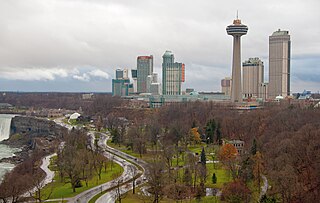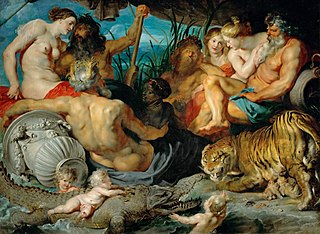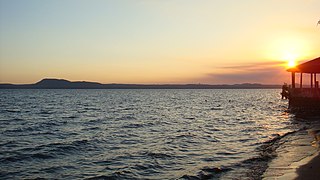
Tourism in Spain is a major contributor to national economic life, with foreign and domestic tourism contributing to about 12.4% of Spain's GDP. Ever since the 1960s and 1970s, the country has been a popular destination for summer holidays, especially with large numbers of tourists from the United Kingdom, Ireland, France, Germany, Italy, the Benelux, and the United States, among others. Accordingly, Spain's foreign tourist industry has grown into the second-biggest in the world.

Tourism in France directly contributed 79.8 billion euros to gross domestic product (GDP) in 2013, 30% of which comes from international visitors and 70% from domestic tourism spending. The total contribution of travel and tourism represents 9.7% of GDP and supports 2.9 million jobs in the country. Tourism contributes significantly to the balance of payments.

Niagara Falls is a city in Ontario, Canada, adjacent to, and named after, Niagara Falls. As of the 2021 census, the city had a population of 94,415. The city is located on the Niagara Peninsula along the western bank of the Niagara River, which forms part of the Canada–United States border, with the other side being the twin city of Niagara Falls, New York. Niagara Falls is within the Regional Municipality of Niagara and a part of the St. Catharines - Niagara Census Metropolitan Area (CMA).

Canada has a large domestic and foreign tourism industry. The second largest country in the world, Canada's wide geographical variety is a significant tourist attractor. Much of the country's tourism is centred in the following regions: Toronto, Montreal, Quebec City, Vancouver/Whistler, Niagara Falls, Vancouver Island, Canadian Rockies, British Columbia's Okanagan Valley, Churchill, Manitoba and the National Capital Region of Ottawa-Gatineau. The large cities are known for their culture, diversity, as well as the many national parks and historic sites.

Cultural tourism is a type of tourism in which the visitor's essential motivation is to learn, discover, experience and consume the cultural attractions and products offered by a tourist destination. These attractions and products relate to the intellectual, spiritual, and emotional features of a society that encompasses arts and architecture, historical and cultural heritage, culinary heritage, literature, music, creative industries as well as the living cultures with their lifestyles, value systems, beliefs and traditions.

The Stratford Festival is a theatre festival which runs from April to October in the city of Stratford, Ontario, Canada. Founded by local journalist Tom Patterson in 1952, the festival was formerly known as the Stratford Shakespearean Festival, the Shakespeare Festival and the Stratford Shakespeare Festival. The festival was one of the first arts festivals in Canada and continues to be one of its most prominent. It is recognized worldwide for its productions of Shakespearean plays.

Tourism in Mexico holds considerable significance as a pivotal industry within the nation's economic landscape. Beginning in the 1960s, it has been vigorously endorsed by the Mexican government, often heralded as "an industry without smokestacks," signifying its non-polluting and economically beneficial nature.

Foumban or Fumban is a city in Cameroon, lying north east of Bafoussam. It has a population of 83,522. It is a major town for the Bamoun people and is home to a museum of traditional arts and culture. Foumban is known for its political significance in the formation of Cameroon's history and its cultural, tourism and economic potential. There is also a market and a craft centre, while Foumban Royal Palace contains a museum with information on Ibrahim Njoya who invented a new language script, Bamum script, and the artificial language Shümom.
An arts district or cultural district is a demarcated urban area, usually on the periphery of a city centre, intended to create a 'critical mass' of places of cultural consumption - such as art galleries, theatres, art cinemas, music venues, and public squares for performances. Such an area is usually encouraged by public policy-making and planning, but sometimes occurs spontaneously. It is associated with allied service-industry jobs like cafes, printers, fashion outlets, restaurants, and a variety of 'discreet services'.

A work of art, artwork, art piece, piece of art or art object is an artistic creation of aesthetic value. Except for "work of art", which may be used of any work regarded as art in its widest sense, including works from literature and music, these apply principally to tangible, physical forms of visual art:

Alberta has been a tourist destination since the early days of the 20th Century, with attractions including national parks, National Historic Sites of Canada, urban arts and cultural facilities, outdoor locales for skiing, hiking and camping, shopping locales such as West Edmonton Mall, outdoor festivals, professional athletic events, international sporting competitions such as the Commonwealth Games and Olympic Winter Games, as well as more eclectic attractions.

The city of Thiruvananthapuram has been the centre of cultural activities of Kerala (India) from the time it was made capital of Travancore in 1745. The capital city is a major intellectual and artistic center. The Thiruvananthapuram Museum and Thiruvananthapuram Zoo were started during the reign of Swathi Thirunal (1813–1847) and are one of the oldest of their kind in India. The city's libraries include the Thiruvananthapuram Public library, which was started in 1829. The Swathi Thirunal College of Music and 'College of fine arts' are the leading institutions related to music and arts.
Montreal was referred to as "Canada's Cultural Capital" by Monocle Magazine. The city is Canada's centre for French-language television productions, radio, theatre, film, multimedia, and print publishing. The Quartier Latin is a neighbourhood crowded with cafés animated by this literary and musical activity. Montreal's many cultural communities have given it a distinct local culture.
Haitian art is a complex tradition, reflecting African roots with strong Indigenous, American and European aesthetic and religious influences. It is an important expression of Haitian culture and history.

Ypacaraí Lake is a major body of water located in Paraguay, about 50 kilometres (31 mi) east of the capital, Asunción. The lake lies in the western part of the Asunción-Sapucai-Villarrica graben, a tectonic depression from the Mesozoic Era, and drains to the northwest through the Salado River into the Paraguay River. It is surrounded by three cities: Areguá, Ypacaraí, and San Bernardino, the last two being located on its shore. It is one of Paraguay's two main lakes, providing water for drinking and irrigation, and is also the site of many leisure activities.
The culture of Paris concerns the arts, music, museums, festivals and other entertainment in Paris, the capital city of France. The city is today one of the world's leading business and cultural centers; entertainment, music, media, fashion, and the arts all contribute to its status as one of the world's major global cities.

Stratford-upon-Avon College is an English further education college in Stratford-upon-Avon, Warwickshire.
The Nelsonville Music Festival is an annual four-day music festival located at Snow Fork near Nelsonville, Ohio. The event in Southeastern Ohio takes place in July and features a variety of musical genres and includes local, regional, national and international artists. The weekend celebration includes local food and artisans as well as a campground for both primitive and RV camping. The festival also provides activities for children and strives to be environmentally friendly.
Tourism in Brittany attracts around 13 million visitors a year. An important sector of the region's economy, it accounts for just under 10% of the region's GDP, and directly employs just under 70,000 people. Seasonal activity extends from May to September, and is mainly concentrated on the coast, particularly in the departments of Finistère and Morbihan.
Mary E. Hofstetter is a Canadian arts administrator and educator who served as president of Sheridan College from 1988 to 1996, general manager of the Stratford Festival from 1996 to 1998, and president of the Banff Centre for Arts and Creativity from 1999 to 2011.














